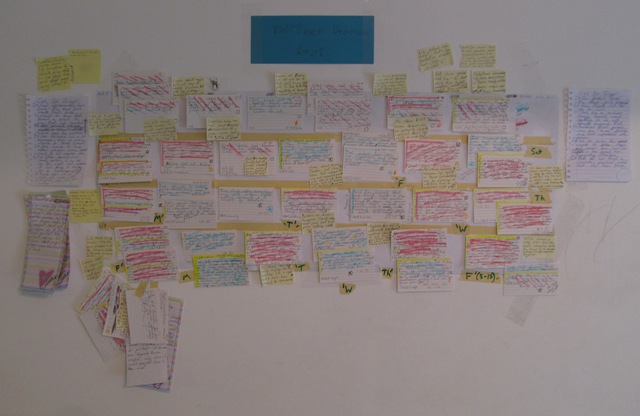When Daniel tagged me in a blog hop with the subject of ‘My Writing Process’ I was excited to jump in and discuss.  Except, when I took a close look at my writing process, it looked on first glance like I don’t have one.
After all, I’ve had books that I sat down and grilled through in a matter of weeks–start to finish–and required very little rewrites beyond the cosmetic. Â And I’ve had books that bear less resemblance to their original form than a squigly brown dragonfly larvae to the dragonfly it will one day become.
And while sometimes I’m firmly obedient to the age old writing advice that a writer must write, and that means every day…other times I stop writing for days at a time while I bang my head against a plot point or simply sit in the sun and breathe. Â So, then, what is my process?
A good question–and here’s my answer: My process is one of discovering stories by absorbing life as it sifts through my soul, and writing it down.
Isn’t that a lovely bit of imagery? Â In practical terms, the kind that can actually be useful to another writer, there are a few things consistent from book to book in how I work.
- I must have a sense for the story heart. Â This usually starts for me when a combination of two or three things inexplicably come together–a boy who leaves his body behind in order to search out ancient relics in the ether, then hunts them down back on the physical plane and recovers them for a fee–and around the woven mass of this story kernel, I also have a sense for people I can care about. Â That’s how my short story ‘Watcher in the Dark‘ got its start, and my other stories began in much the same way.
- I spend time exploring the plot of the story, the way these elements can spin together. Â As pieces and bits, they have potential to go in several different directions, and I try to choose the direction which makes for the most conflict, emotional growth, and wry humor. Â When I think I’ve got it (loosely) figured out, I write it all down on 3×5 cards in a great big plot on the wall, and start writing.
- I discover that my plot won’t work, because it’s missing some crucial bit or because a new character has shown up and changed everything. Â This usually occurs somewhere between chapters three and six, and always before I reach the one quarter mark in the book. Â I throw out almost everything on my previously written up 3×5 cards, and incorporate all the new stuff. Â Nowadays this often involves very loose plotting because I know where I”m going and can trust the plot ahead of me. Â In my first few novels, though, that tricky step between 2 and 3 in which I carefully plotted the cards, then threw them out again, was repeated over and over.
- I finish the novel, set it aside, and on coming back to it find I have to rewrite (sometimes a tweak, sometimes an overhaul) the beginning, the end, or both.
That’s my process as it stands now–and it’s a thing of beauty! Â Except when it’s uglier than a traffic jam on Halloween night with sleet and slush falling steadily and the little kids crying as they sit, sweating, in their costumes. Â I also kind of expect that process to change, as I continue to write and mature as a writer. Â Because I really do believe that stuff I said–that stories and writing are what come when I’ve sifted life through my soul. Â And how could that be something which stays the same?
But, maybe it’s different for you. Â Maybe your process is something steady, and reliable. Â I know some writers even have rituals which stay with them no matter where they write or what kind of story they’re putting together. Â Tell me, what’s your secret to success? Â I’d love to hear what sparks your writing, and how you capture that spark and nurture it into flame!
To that end, I’m tagging several of my writing friends to join in the blog hop and tell us about their process. Â Here’s looking at you, Ginger, Pat, Laura, and Rebecca!



Sandy Brehl
C Michelle Jefferies
Suzanne
Suzanne Warr
C Michelle Jefferies
Suzanne Warr
C Michelle Jefferies
Pat Esden
Suzanne
Ginger
Suzanne
Rebecca Blevins
Suzanne